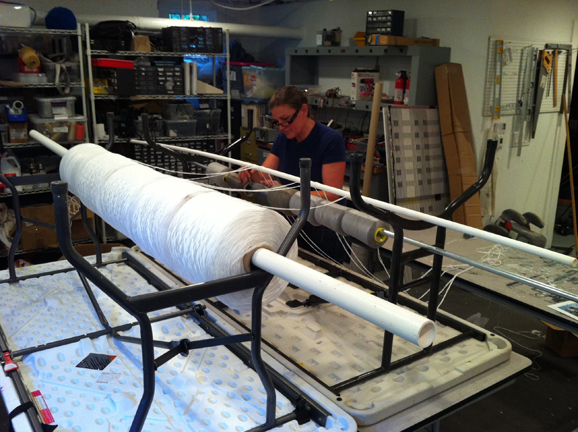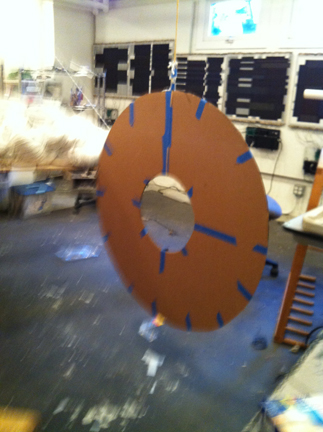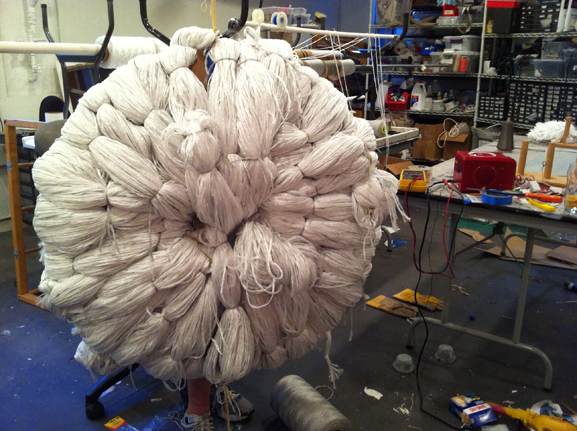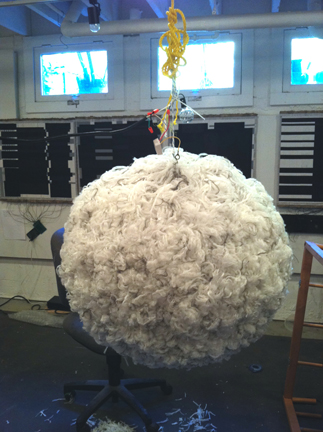| Maggie Orth | ||
| Art, Technology, Design | ||
 |
The Fuzzy Apparatus, 2013
Recycled carpet fibers, conductive yarn, lamp parts. Pompom, 34" x 34"; tether, 18';
lightbulb, 16" x 12". The Fuzzy Apparatus is a monumental patented electronic pompom, and a witty, surrealistic instantiation of my United States Utility Patent: Electronic Textile Touch Light Controller, US Patent 7,054,133, 2004. Viewers touch the giant pompom to turn on and dim the giant light bulb. When I patented fuzzy sensors and electronic pompoms in 2004, I had conflicting intentions. As an entrepreneur, I certainly hoped to exploit my invention economically; to sell and market my fuzzy sensors as products and technology. (See my PomPom Dimmer here.) Artistically, I saw the act of patenting an electronic pompom as a transgressive and humorous invasion into the esteemed world of technology. Turning a piece of fru fru frippery into a functional patented technology was, from my point of view, akin to putting a toilet on the wall. I also intended to raise questions about the marginalization of the decorative in modern and contemporary design, and the simplistic and stifling design mantra of "form follows function". For many years, my conflicting commercial and artistic intentions around this patent were a source of anxiety. But all art exists in an economic framework, with sponsors and patrons and buyers. And finding a way to fund and keep making your art is challenge for all artists. A challenge that necessitates economic activity.
|
|||||||||
studio shot, 2013 |
||||||||||
| Fabrication (scroll down for fabrication images)
Creating a giant pompom was a surprising engineering challenge. Just having enough yarn to make a pompom this big is unusual. Fortunately, I had nine industrial-sized spools of white carpet yarn leftover from my company, International Fashion Machines. While getting the yarn off the spools was difficult, my biggest challenge was making the pompom round. Usually the weight of the long yarn causes the pompom to droop. I solved this problem by creating an internal structure of cable ties to hold up the yarn. In addition, the recycled carpet yarn I was working with could be felted and stiffened with I heat, so a tumble in a commercial drier and hours of fluffing and shaping the pompom with my hands and a heat gun did the trick. |
||||||||||
|
||||||||||
 |
||||||||||
Winding a giant pompom strand by strand is nearly impossible, so my first challenge was to get the yarn off the spools and wound into skeins fast. So I created a giant yarn spooler by turning upside down two folding tables and hanging plastic pipe in leg bases. This impromptu yarn spooler held 6 spools of carpet yarn and 8 spools of conductive yarn. For this piece I used a variety of conductive yarns. Fortunately, I had a lot in stock. |
||||||||||
 |
||||||||||
|
|
||||||||||
My next step was to wind the yarn onto a warp board to make skeins. I made fifteen skeins of yarn, about 15 feet long and 4 inches in diameter. |
||||||||||
 |
 |
|||||||||
| Above, on the right, are a few of the skiens and my pink gloves piled on an earlier prototype for this piece. The conductive yarn was sharp, so I wore gardne gloves to spool out the yarn. On the left is the 36" x 36" cardboard pompom maker hanging from my studio ceiling. It consists of two cardboard rings taped together. The internal rope tether, which was used to cinch the pompom after the skiens were wound around the cardboard doughnut, was pre-taped between the two layers. While I have used other methods for making pompoms in the past, I decided to use the tradiational pompom maker ring because I wasn't sure that I could cinch the tether tight enough to make the pompom puff out, or guarantee the proper shape. | ||||||||||
 |
 |
|||||||||
| On the left is the pompom maker hanging from my ceiling and covered with the skiens of yarn. After I wrapped the skiens around the pompom maker, I sewed them together in the center with kevlar (for strength) and conductive yarn to ensure electrical continuity. Then I cut the skiens along the edge of the doughnut to release the pompom. On the right is the pompom after tumble in a commercial drier and before I attached the braided tether and lightbulb. I made the tether by creating 4, 30 foot skiens of white and grey carpet yarn and then braiding them around lamp wire and 2 strands of 550 paracord. The giant lightbulb is a modified lamp I bought on eBay. | ||||||||||